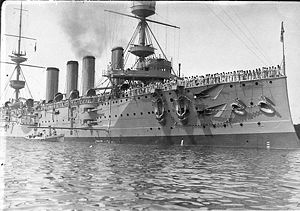HMS Powerful (1895)

Sailors on deck of four-funnel cruiser HMS Powerful, Australian Squadron, Sydney Harbour (between 1902-1913)
|
|
| History | |
|---|---|
|
|
|
| Name: | HMS Powerful |
| Builder: | Vickers Limited, Barrow-in-Furness |
| Laid down: | 1894 |
| Launched: | 24 July 1895 |
| Renamed: | Impregnable, November 1919 |
| Reclassified: | Training School, November 1919 |
| Fate: | Sold 31 August 1929 |
| General characteristics | |
| Class and type: | Powerful-class cruiser |
| Displacement: | 14,200 tons deep load |
| Length: | 500 ft (150 m) |
| Beam: | 71 ft (22 m) |
| Draught: | 27 ft (8.2 m) |
| Propulsion: |
|
| Speed: | 22 knots (41 km/h) |
| Range: | 7,000 nautical miles (13,000 km) at 14 knots (26 km/h) |
| Endurance: | 3000 tons coal |
| Complement: | 894 |
| Armament: |
|
| Armour: |
|
HMS Powerful was a ship of the Powerful class of protected cruisers in the Royal Navy. She served with her sister ship, Terrible, on the China Station and provided landing parties which fought in the relief of the Siege of Ladysmith in the Second Boer War. Crews from the two ships also took part in suppressing the Boxer Rebellion in China. After 1904 they were laid up as an economy measure.
Powerful was built by Vickers Limited, Barrow-in-Furness and launched on 24 July 1895 by the Duchess of Devonshire.
In 1897 Captain Hedworth Lambton commanded Powerful, which was one of the largest warships of the time, on a posting to China. On the return voyage in 1899 he was ordered to Durban, South Africa at an important point in the Second Boer War. He stopped at Mauritius, and on his own initiative picked up a battalion of soldiers stationed there. Knowing that the British forces at Ladysmith urgently needed more powerful guns, Captain Percy Scott from Powerful's sister ship, Terrible, devised carriages to transport naval cannon, and Lambton then led a Naval Brigade from Powerful to the rescue with four 12-pounders and two other guns.
The journey to Ladysmith from Durban was 189 miles (304 km). They began by special train then with oxen pulling the guns but when the oxen died the sailors took over pulling the guns themselves. In this endeavour they manhandled the guns "through the wild and broken country" of the South African veldt and "arrived in the nick of time" to play "a most important role in the defence of the town". Although the Boer attackers were kept at bay unfortunately the Naval brigade became besieged themselves. A second Naval brigade from Terrible left Durban for Ladysmith and joined with the relief column led by General Buller and assisted in the lifting of the siege.
...
Wikipedia
